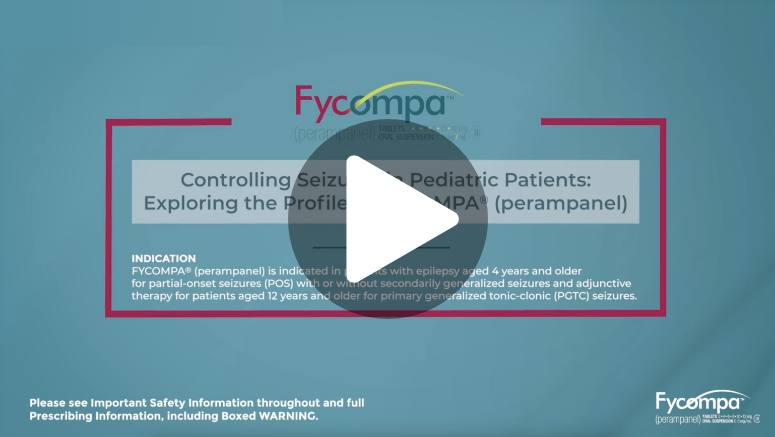[Music]
Hi, I’m Dr Jesus Eric Piña-Garza.
An important consideration when treating adolescents with epilepsy is whether the antiseizure medications we use have any effects on cognitive function. I think it’s so important, as children go through formal education, that we minimize any impact their epilepsy treatment may have on their achievement. And certainly, I have had many parents express concern about how their children’s medication will affect thinking and function.
Unfortunately, some antiseizure medications may negatively affect cognition, and for others, we simply do not have the data to know.
My colleagues and I decided to study what effect FYCOMPA (perampanel) may have on cognition in adolescents who were started on the medications because of inadequately controlled partial seizures. We also looked at efficacy, safety and tolerability, and growth and development.
Before I discuss the study, it’s important that you are familiar with the efficacy and safety profile of FYCOMPA as established in pivotal clinical trials. If have you not already done so, please review the other videos on this website that describe the pivotal data for FYCOMPA, and then resume watching this video.
Okay, now let’s look more closely at our cognition study.
Our study was an extension of a 19-week, multicenter, randomized, double-blind, placebo-controlled, parallel-group, phase 2 study conducted at 39 centers across 11 countries.
All patients had partial seizures with or without secondary generalization that were inadequately controlled despite receiving 1 to 3 antiepileptic medications.
Patients who completed all scheduled visits in the double-blind phase were eligible to participate in the open-label extension.
Part A of our study was a 6-week, double-blind conversion period. Patients receiving FYCOMPA in the double-blind phase continued at the dose they were taking at end of that phase.
Patients who had been randomized to placebo in the double-blind phase were switched to FYCOMPA 2 mg/day, uptitrated weekly in 2-mg increments.
This was followed by a 27-week, open-label maintenance period.
The part B of our study was an additional open-label extension period of 15 to 52 weeks.
And again, we looked at measures of cognition, efficacy and safety, as well as growth and development.
Note that our study does have some limitations, including the fact that it was an open label, enrolled a relatively small number of patients, and lacked a placebo or active control group.
Here is a look at some of the baseline characteristics of the adolescents in the study.
Much of this mirrors my practice population, in particular the diverse seizure types and the many patients receiving multiple antiseizure medications with different mechanisms of action.
And the reason for the concomitant medications in my practice is often that the initial treatment doesn’t provide adequate control of seizures.
So, we looked at cognition compared to baseline as measured by CDR system score, across 5 cognitive domains—power and continuity of attention, quality of episodic and working memory, and speed of memory. The CDR system provides a standardized way to look at these different domains of brain function.
This graphic shows the global score and the score for each domain, at baseline and after up to 52 weeks of treatment.
In my practice, I use measures of cognition to help ensure…
… I am striking a balance between controlling a child’s seizures and ensuring that they are able to do their best academically.
And I think it’s really important to make sure we make baseline assessments before treatment, so we understand that effects may or may not be related to the medication.
Here we see the median percentage reduction in seizure frequency per 28 days.
Each plotted line represents the subset of patients with that total duration of exposure to FYCOMPA. The weeks along the x-axis represent the study timepoints.
For patients who were exposed to FYCOMPA for 52 or more weeks and had data available, the median reduction in seizure frequency was 74.1% at weeks 40 to 52.
And here is the 50% responder rate over time, again shown by patients’ total duration of FYCOMPA exposure.
For patients who were exposed to FYCOMPA for 52 or more weeks and had data available, the median 50% responder rate was 66% at weeks 40 to 52.
The safety profile of FYCOMPA in this study was consistent with that observed in prior clinical studies.
The most common treatment-emergent adverse events included dizziness and somnolence.
The most common treatment-emergent adverse events related to hostility or aggression were aggression and irritability.
The majority of the most common treatment-emergent adverse events occurred early in treatment.
Among patients who received FYCOMPA for 52 or more weeks, the incidence of the most common adverse events was 74.6% at Weeks 1 to 13 and 26.9% at Weeks 40 to 52.
Treatment-emergent adverse events resulted in treatment discontinuation in 7 patients.
23 serious adverse events occurred in 19 patients. Only 2 occurred in more than 1 patient: and that was convulsion and aggression.
And I am sure to address the potential for aggression and the Boxed Warning with all of my families. It’s important that they know it’s an uncommon but possible side effect, so they are prepared and can contact me right away if they see any concerning behavior.
I also tell families that I am comfortable with the profile of FYCOMPA and if my children were in a similar situation would not hesitate to use it.
As I said at the beginning, we don’t have data on cognitive effects for all antiseizure medications, but we do have some for FYCOMPA. And this is important because a medication’s antiseizure efficacy should not come at the expense of cognition.
Especially when we are treating children and adolescents, I think it’s very important to consider cognitive function.
Kids need to be able to pay attention in school, memorize information, express themselves clearly…
… do homework, and interact with peers. To me, these are the skills they need to have to be confident and successful.
In my practice, parents often express concern about how antiseizure medication will affect their child. So, it’s so important to have these data on cognitive function.
You know, for my patients with epilepsy, their antiseizure medications are like their long-term companions, helping them throughout their journey. But these companions should be easy to get along with and allow patients to be themselves.
For this reason, for many of my patients, I believe FYCOMPA is a great companion.
Now please stay tuned for additional Important Safety Information for FYCOMPA.
[NARRATOR]
In the partial-onset seizures clinical trials, hostility- and aggression-related adverse reactions occurred in 12% and 20% of patients randomized to receive FYCOMPA at doses of 8 mg and 12 mg per day, respectively, compared to 6% of patients in the placebo group. These effects were dose- related and generally appeared within the first 6 weeks of treatment, although new events continued to be observed through more than 37 weeks. These effects led to dose reduction, interruption, and discontinuation.
The combination of alcohol and FYCOMPA significantly worsened mood and increased anger. Patients should avoid the use of alcohol.
Patients, their caregivers, and families should be informed that FYCOMPA may increase the risk of psychiatric events.
Patients should be monitored during treatment with FYCOMPA, especially when taking higher doses.
Antiepileptic drugs, including FYCOMPA, increase the risk of suicidal thoughts or behavior in patients.
Patients, their caregivers, and families should be informed of the risk and advised to monitor and immediately report the emergence or worsening of depression, suicidal thoughts or behavior, thoughts about self-harm and/or any unusual changes in mood or behavior.
FYCOMPA caused dose-related increases in events related to dizziness and disturbance in gait or coordination, especially during the titration phase.
FYCOMPA caused dose-dependent increases in somnolence and fatigue-related events, especially during the titration phase.
Patients should be advised against engaging in hazardous activities requiring mental alertness, such as operating motor vehicles or dangerous machinery, until the effect of FYCOMPA is known.
Patients should be carefully observed for signs of central nervous system depression when FYCOMPA is used with other drugs with sedative properties because of potential additive effects.
Falls were more common in patients taking FYCOMPA at doses of 8 mg and 12 mg versus placebo.
Drug reaction with eosinophilia and systemic symptoms, or DRESS, also known as multiorgan hypersensitivity, has been reported in patients taking AEDs, including FYCOMPA. DRESS may be fatal or life-threatening.
Evaluate your patients if these signs or symptoms are present.
A gradual withdrawal is generally recommended with AEDs to minimize the potential of increased seizure frequency.
The most common adverse reactions include dizziness, somnolence, fatigue, irritability, falls, nausea, weight gain, vertigo, ataxia, headache, vomiting, contusion, abdominal pain, and anxiety.
FYCOMPA may decrease the efficacy of contraceptives containing levonorgestrel.
Plasma levels of perampanel were decreased when administered with moderate and strong CYP3A4 inducers.
FYCOMPA may enhance the effects of alcohol on vigilance, alertness, anger, confusion, and depression.
These effects may also be seen when FYCOMPA is used in combination with other CNS depressants.
Caution should be exercised when FYCOMPA is administered to pregnant or nursing women.
Use in patients with severe hepatic or severe renal impairment is not recommended.
Dosage adjustments are recommended in patients with mild or moderate hepatic impairment.
Use with caution in patients with moderate renal impairment.
FYCOMPA is a Schedule III controlled substance and has the potential to be abused and lead to drug dependence and withdrawal symptoms.
Thanks for watching. For more information about FYCOMPA, please visit FYCOMPAonDEMAND.com


